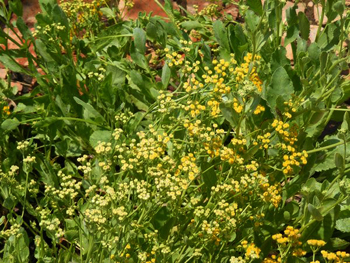Contents:
Common Names | Parts Usually Used | Plant(s) & Culture | Where Found | Medicinal Properties | Biochemical Information
Legends, Myths and Stories | Uses | Formulas or Dosages | Bibliography
Scientific Names

- Chrysanthemum balsamita L.
- Tanacetum balsamita L.
- Pyrethrum balsamita
- Compositae
- Composite family
Common Names
- Alecoast
- Alecost
- Bible leaf
- Sweet Mary
Parts Usually Used
Leaves
Back to Top
Description of Plant(s) and Culture
Costmary has small daisy-like flowers with white ray petals. Its leaves have a strong camphorlike mild scent. Grows to 12 inches tall, with gray-green leaves and 3-foot-tall flower stalks with insignificant yellow flowers. The shiny, pear shaped light green leaves are 6-8 inches long with finely, short, sturdy, and slightly downy branches. Blooms in late summer. The plant forms no seeds.
Back to Top
Where Found
Grows in sandy soil as well as well-drained clay soil.
Back to Top
Medicinal Properties
Astringent, antiseptic, aperient, aromatic, carminative, diaphoretic
Back to Top
Biochemical Information
Essential oils and other constituents not identified
Back to Top
Legends, Myths and Stories
More than a thousand years ago, Costmary was taken from its native home of India and brought to Asia Minor. From there it was carried to most parts of Europe and then to the New World. It was reared in New England gardens and brought westward to the Rockies with civilization. Here the plant seems to have reached the end of its journey as well as popularity. It is now found mainly in the wild state on very old farm sites. Costmary is a handsome, silvery yellow green plant with scent similar to Spearmint. The plant forms clusters of base leaves with slender stalks of daisy like flowers. Formerly dried branches were tied with lavender and placed in chests and drawers as moth repellent and to give linens a fresh sweet scent. The leaves were used to make “sweete washing water.” Because of its taste and aroma, the herb was used to give ale a spicy flavor. For this reason, it was known also as Ale-cost.
The leaves of costmary are put in Bibles or in linens to give a sweet aroma. A leaf often served as a bookmark in the Bibles and prayerbooks of churchgoers. Costmary has always had a special place in Christianity. When the sermon grew boring and drowsiness set in, the sleepy listener treated self to a minty flavor of the costmary leaf in an effort to stay awake. Therefore, the nickname “Bible leaf” grew popular.
Ages ago, costmary leaves were dropped into a drooping pint of ale to bring the drink back to life. Very popular among beer drinkers.
The name of this sweet-smelling herb combines the Latin word costus (meaning fragrant root) with “Mary” the mother of Jesus. In medieval France costmary was called “Herbe Sainte-Marie”, but other references identify it with Mary Magdalene as often as the Virgin Mary. According to medieval legend, costmary was the balsam with which Mary Magdalene washed Jesus’ feet.
Originally found in the Orient, it was introduced into England in the 16th century and soon became extremely popular.
A relative of the “mums” with a minty flavor. A 220 year old book states: “Many people are fond of this herb in soups. The French used leaves to give fragrance to salads.” Found growing in New England and old home-sites.
Back to Top
Uses
Early use of Costmary was to ease the pain of childbirth. Crushed costmary leaves help ease the pain and swelling of a bee sting. Useful in the treatment of dysentery and diarrhea, worms, colds, flu, fever, indigestion, gas, rheumatism, ointment used for bruises, heals old ulcers, sores, dry itches, strains of veins and sinews, burns, the shingles, blisters, external vermin, and scabs.
Back to Top
Formulas or Dosages
Standard infusion or 3-9 grams; tincture, 10-30 drops.
Back to Top
Bibliography
![]() The Herb Book
The Herb Book, by John Lust, Bantam Books, 666 Fifth Avenue, New York, NY. copyright 1974.
![]() Culpeper’s Complete Herbal & English Physician: Updated With 117 Modern Herbs
Culpeper’s Complete Herbal & English Physician: Updated With 117 Modern Herbs, by Nicholas Culpeper, Meyerbooks, publisher, PO Box 427, Glenwood, Illinois 60425, 1990, (reprint of 1814)
![]() The Herbalist Almanac
The Herbalist Almanac, by Clarence Meyer, Meyerbooks, publisher, PO Box 427, Glenwood, Illinois 60425, copyright 1988, fifth printing, 1994
Herbal Gardening, compiled by The Robison York State Herb Garden, Cornell Plantations, Matthaei Botanical Gardens of the University of Michigan, University of California Botanical Garden, Berkeley., Pantheon Books, Knopf Publishing Group, New York, 1994, first edition
![]() Planetary Herbology
Planetary Herbology, by Michael Tierra, C.A., N.D., O.M.D., Lotus Press, PO Box 325, Twin Lakes. WI 53181., Copyright 1988, published 1992
![]() Webster’s New World Dictionary
Webster’s New World Dictionary, Third College Edition, Victoria Neufeldt, Editor in Chief, New World Dictionaries: A Division of Simon & Schuster, Inc., 15 Columbus Circle, New York, NY 10023
 The Rodale Herb Book: How to Use, Grow, and Buy Nature’s Miracle Plants (An Organic gardening and farming book)
The Rodale Herb Book: How to Use, Grow, and Buy Nature’s Miracle Plants (An Organic gardening and farming book), edited by William H. Hylton, Rodale Press, Inc. Emmaus, PA, 18049., 1974
 Old Ways Rediscovered
Old Ways Rediscovered, by Clarence Meyer, Meyerbooks, publisher, PO Box 427, Glenwood, Illinois 60425, published from 1954, print 1988
![]() Country Home Book of Herbs
Country Home Book of Herbs, Meredith Books, Editorial Dept. RW240, 1716 Locust Street, Des Moines, IA 50309-3023, copyright 1994
